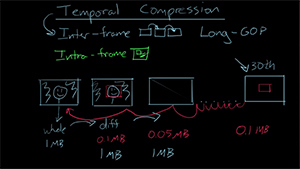The current industry preferred codec, H.264, took over six years to mature to full end-to-end support and polished transcoding efficiency. HEVC’s timeline, however, should be accelerated compared to that of H.264. The migration to HEVC from H.264 is more of a maturation of technologies into an advanced state whereas the adoption of H.264 was a major jump from existing technologies.
The reason there’s so much fervor over HEVC is because of the many improvements it promises over its predecessors. The most prominent is its encoding efficiency. HEVC is expected to provide the same quality at half the data rate, reducing the demands on Wi-Fi and cellular networks, or twice the resolution at the same data rate, allowing HD content where it wasn’t feasible prior. Some are skeptical that this will aid in relieving network requirements arguing that HEVC will actually worsen the situation. Why? Because the lessened requirement on connection speeds is going to create and facilitate drastically greater demand. Video is already the majority of Internet traffic and is poised to become the dominant data type in the near future as demand continues to grow.
Another boon, albeit one that is much less talked about, is that image degradation is done in a manner that is much more pleasing to the human eye. As bits are lost the image takes on a smoother, almost softened, look that is less blocky than the compression artifacting of H.264.
Licensing terms for HEVC was initially a major concern for many companies until the terms were made public. H.264’s licensing incurred royalty charges whenever H.264 content was sold as pay-per-view and could have similarly, or to a greater extent, impacted HEVC. However, HEVC has no content-related royalties alleviating many costs that are currently burdened by content creators under H.264 licensing. Yet the terms are more expensive for encoder/decoder manufacturers. Where H.264 had a maximum $6.5 million in possible charges, HEVC’s cap is set at a staggering $25 million. That being said only very large companies that play in this field will be impacted; companies like Adobe, Apple, Google, Microsoft, and Mozilla. Even though this cap will only be felt by such massive companies it may greatly hinder or even prevent widespread adoption. Adobe recently announced its decision to not implement HEVC support in Flash. This may sound like an odd move, but with the global saturation of the Flash player Adobe would be facing a $25 million expenditure the quarter it implements HEVC when their quarterly net income is only around $50 million. That’s a hard pill to swallow for investors especially when Adobe and these other companies will be shouldering the cost so that content providers can distribute their content with no fees and no return for Adobe.
As with any technology in its early stages there are a few reasons to not rush in to migrating to HEVC. Currently encoding to HEVC requires drastically more power than H.264. For the individual this increase is negligible, but for massive companies such as Netflix this can be a substantial cost increase. In addition, the efficiency of current encoders is upwards of ten times that of H.264. Not only does this increase your time to deliverable file, but it also makes real-time encoders currently impossible. Early adopters are also reporting that encoding resolutions at or below 720p aren’t yielding appreciable file size savings. Even with similar file sizes they are seeing an increase in perceived quality of the video. As the technology matures the efficiency and power needs will improve addressing and alleviating these problems with real-time encoders likely just a few years away.
Several other reasons loom over HEVC, but these will also be alleviated with time. Encryption and digital rights management (DRM) for protecting the delivery of content is still emerging. Something that many content owners will require before they award approval for distribution of their content. UHDTVs, a major venue for HEVC content, are still nascent in ownership. Lastly the cost of replacing copious hardware and software systems for transcoding into HEVC looms over current companies.
With all of the benefits awaiting us with HEVC there is prudence in not rushing to quickly into adoption. As time passes and the technology matures we’ll see some truly great video in places we haven’t yet been able to.






